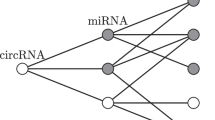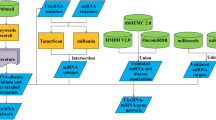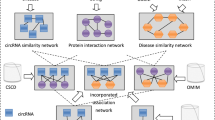Abstract
Circular RNA, a molecule with partially understood functions, has been implicated in various diseases. Therefore, there is a vast effort to predict associations between circular RNAs and diseases. In our recent study, we introduced circGPA, an algorithm that enables the annotation of circular RNAs with gene ontology terms through interactions with miRNAs and mRNAs. Recognizing the analytical similarity in predicting disease associations, we developed GPACDA, an extension of circGPA tailored for disease associations. The benefits of our methods include explainability, as the outputs are based on known interactions and associations, as well as the rigorous calculation of the p-value, which the circGPA algorithm can compute. We compared our method with two other tools, NCPCDA and DWNCPCDA, using a subset of the CDASOR dataset and showed that GPACDA overcomes its competitors in terms of true association ranks. Our method’s code and predictions are publicly accessible.
Access this chapter
Tax calculation will be finalised at checkout
Purchases are for personal use only
Similar content being viewed by others
References
Beau, M.M., et al.: Cytogenetic and molecular delineation of a region of chromosome 7 commonly deleted in malignant myeloid diseases. Blood 88(6) (1996)
Bekker, J., et al.: Learning from positive and unlabeled data: a survey. ML (2020)
Benjamini, Y., Hochberg, Y.: Controlling the false discovery rate: a practical and powerful approach to multiple testing. JRSS. Series B 57(1) (1995)
Cardenas, J., et al.: Cerina: systematic circRNA functional annotation based on integrative analysis of ceRNA interactions. Sci. Rep. 10(1) (2020)
Chen, Y., et al.: Deep learning models for disease-associated circRNA prediction: a review. Brief. Bioinform. 23(6) (2022)
Deepthi, K., Jereesh, A.: An ensemble approach for circrna-disease association prediction based on autoencoder and deep neural network. Gene 762 (2020)
Dong, R., et al.: CIRCpedia v2: an updated database for comprehensive circular RNA annotation and expression comparison. GPB 16(4) (2018)
Dudekula, D.B., et al.: CircInteractome: a web tool for exploring circular RNAs and their interacting proteins and microRNAs. RNA Biol. 13(1) (2016)
Dunn, O.J.: Multiple comparisons among means. JASA 56(293) (1961)
Ebner, J., et al.: Abcc1 and glutathione metabolism limit the efficacy of bcl-2 inhibitors in acute myeloid leukemia. Nat. Commun. 14(1) (2023)
Feller, W.: Introduction to probability theory and its applications (1966)
Franzini, A., et al.: Molecular alterations in chronic myelomonocytic leukemia monocytes: transcriptional and methylation profiling. Blood 132 (2018)
Gorombei, P., et al.: BCL-2 inhibitor ABT-737 effectively targets leukemia-initiating cells with differential regulation of relevant genes leading to extended survival in a NRAS/BCL-2 mouse model of high risk-MDS. IJMS 22(19) (2021)
Guinn, B., et al.: Humoral detection of leukaemia-associated antigens in presentation acute myeloid leukaemia. BBRC 335(4) (2005)
Guo, Y., Yi, M.: THGNCDA: circRNA-disease association prediction based on triple heterogeneous graph network. Brief. Funct. Genom. (2023)
Hsu, S.D., et al.: miRTarBase: a database curates experimentally validated microRNA-target interactions. Nucleic Acids Res. 39(suppl_1) (2010)
Huang, Z., et al.: HMDD v3.0: a database for experimentally supported human microRNA-disease associations. Nucleic Acids Res. 47(D1) (2018)
Hussein, K., et al.: Profile of fibrosis-related gene transcripts and megakaryocytic changes in the bone marrow of myelodysplastic syndromes with fibrosis. Ann. Hematol. 97 (2018)
Jiang, Q., et al.: miR2Disease: a manually curated database for microRNA deregulation in human disease. Nucleic Acids Res. 37(suppl_1) (2008)
Karagkouni, D., et al.: DIANA-TarBase v8: a decade-long collection of experimentally supported miRNA-gene interactions. NAR 46(D1) (2017)
Kumar, B., et al.: Acute myeloid leukemia transforms the bone marrow niche into a leukemia-permissive microenvironment through exosome secretion. Leukemia 32(3) (2018)
Lan, W., et al.: Benchmarking of computational methods for predicting circRNA-disease associations. Brief. Bioinform. 24(1) (01 2023)
Lei, X., et al.: Predicting circRNA-disease associations based on improved collaboration filtering recommendation system with multiple data. Front. Genet. (2019)
Lei, X., et al.: PWCDA: path weighted method for predicting circRNA-disease associations. Int. J. Mol. Sci. 19(11) (2018)
Lewis, B.P., et al.: Conserved seed pairing, often flanked by adenosines, indicates that thousands of human genes are MicroRNA targets. Cell 120(1) (2005)
Li, G., et al.: NCPCDA: network consistency projection for circRNA–disease association prediction. RSC Adv. 9(57) (2019)
Li, G., et al.: Potential circRNA-disease association prediction using DeepWalk and network consistency projection. J. Biomed. Inform. 112 (2020)
Li, S., et al.: Expression profile and bioinformatics analysis of circular RNAs in acute ischemic stroke in a South Chinese Han population. Sci. Rep. 10(1) (2020)
Liang, S., et al.: HMCDA: a novel method based on the heterogeneous graph neural network and metapath for circrna-disease associations prediction. BMC Bioinform. 24(1) (2023)
Liu, F., et al.: Slc25a1-associated prognostic signature predicts poor survival in acute myeloid leukemia patients. Front. Genet. 13 (2023)
Liu, L., et al.: Mutated genes and driver pathways involved in myelodysplastic syndromes - a transcriptome sequencing based approach. Mol. BioSyst. 11 (2015)
Lu, C., et al.: Improving circRNA-disease association prediction by sequence and ontology representations with convolutional and recurrent neural networks. Bioinformatics 36(24) (2020)
Ma, Y., et al.: The expression of beta-tubulin gene in myelodysplastic syndrome evoluting to leukemia. Zhonghua nei ke za zhi 55(5) (2016)
Ma, Y., et al.: Prospective nested case–control study of feature genes related to leukemic evolution of myelodysplastic syndrome. Mol. Bio. Rep. 40(1) (2013)
Manukjan, G., et al.: GaBP is necessary for stem/progenitor cell maintenance and myeloid differentiation in human hematopoiesis and chronic myeloid leukemia. Stem Cell Res. 16(3) (2016)
Mo, G., et al.: Diagnostic approach to the evaluation of myeloid malignancies following car t-cell therapy in b-cell acute lymphoblastic leukemia. JITC 8(2) (2020)
Naudin, C., et al.: PUMILIO/FOXP1 signaling drives expansion of hematopoietic stem/progenitor and leukemia cells. Blood 129(18) (2017)
Oliver, S.: Guilt-by-association goes global. Nature 403(6770) (2000)
Osborne, J.D., et al.: Annotating the human genome with disease ontology. BMC Genom. 10(1) (2009)
Panda, A.C.: Circular RNAs act as miRNA sponges. In: Xiao, J. (ed.) Circular RNAs. Advances in Experimental Medicine and Biology, vol. 1087, pp. 67–79. Springer, Singapore (2018). https://doi.org/10.1007/978-981-13-1426-1_6
Peng, L., et al.: Predicting circrna-disease associations via feature convolution learning with heterogeneous graph attention network. IEEE JBHI 27(6) (2023)
Piñero, J., et al.: DisGeNET: a discovery platform for the dynamical exploration of human diseases and their genes. Database 2015 (2015)
Qu, S., et al.: Circular RNA: a new star of noncoding RNAs. Cancer Lett. (2015)
Ru, Y., et al.: The multiMiR R package and database: integration of microRNA-target interactions along with their disease and drug associations. Nucleic Acids Res. 42(17) (2014)
Ryšavý, P., Kléma, J., Merkerová, M.D.: circGPA: circRNA functional annotation based on probability-generating functions. BMC Bioinform. 23(1) (Sep 2022)
Shi, J.l., et al.: High expression of inositol 1, 4, 5-trisphosphate receptor, type 2 (itpr2) as a novel biomarker for worse prognosis in cytogenetically normal acute myeloid leukemia. Oncotarget 6(7) (2015)
Sweetser, D.A., et al.: Delineation of the minimal commonly deleted segment and identification of candidate tumor-suppressor genes in del(9q) acute myeloid leukemia. Genes Chromosomes Cancer 44(3) (2005)
Szakács, G., et al.: Targeting multidrug resistance in cancer. NRDD 5(3) (2006)
Trsova, I., et al.: Expression of circular RNAs in myelodysplastic neoplasms and their association with mutations in the splicing factor gene sf3b1. Mol. Oncol. (2023)
Verduci, L., et al.: CircRNAs: role in human diseases and potential use as biomarkers. Cell Death Disease 12(5) (2021)
Visconte, V., et al.: Splicing factor 3b subunit 1 (sf3b1) heterozygous mice manifest a hematologic phenotype similar to low risk myelodysplastic syndromes with ring sideroblasts. Blood 122(21) (2013)
Vromman, M., et al.: Closing the circle: current state and perspectives of circular RNA databases. Brief. Bioinform. 22(1) (2020)
Wang, L., et al.: MGRCDA: metagraph recommendation method for predicting circRNA-disease association. IEEE Trans. Cybern. (2021)
Wang, L., et al.: A machine learning framework based on multi-source feature fusion for circRNA-disease association prediction. Brief. Bioinform. 23(5) (2022)
Wu, Q., et al.: MDGF-MCEC: a multi-view dual attention embedding model with cooperative ensemble learning for CircRNA-disease association prediction. Brief. Bioinform. 23(5) (2022)
Wu, W., et al.: Characterization of bone marrow heterogeneity in nk-aml (m4/m5) based on single-cell RNA sequencing. Exp. Hematol. Oncol. 12(1) (2023)
Xiao, F., et al.: miRecords: an integrated resource for microRNA-target interactions. Nucleic Acids Res. 37(suppl_1) (2008)
Yao, D., et al.: Circ2Disease: a manually curated database of experimentally validated circRNAs in human disease. Sci. Rep. 8(1) (2018)
Zhang, H.Y., et al.: iGRLCDA: identifying circRNA-disease association based on graph representation learning. Brief. Bioinform. 23(3) (2022)
Zhao, Q., et al.: Integrating bipartite network projection and KATZ measure to identify novel circRNA-disease associations. IEEE TNB 18(4) (2019)
Zheng, K., et al.: iCDA-CGR: identification of circRNA-disease associations based on chaos game representation. PLOS Comput. Biol. 16(5) (2020)
Zhu, L., et al.: Thbs1 is a novel serum prognostic factors of acute myeloid leukemia. Front. Oncol. 9 (2020)
Šimoničová, K., et al.: Different mechanisms of drug resistance to hypomethylating agents in the treatment of myelodysplastic syndromes and acute myeloid leukemia. Drug Resistance Updates 61 (2022)
Acknowledgment
This work was supported by the Ministry of Health of the Czech Republic - Czech Health Research Council, grant AZV NU20-03-00412.
Author information
Authors and Affiliations
Corresponding author
Editor information
Editors and Affiliations
Rights and permissions
Copyright information
© 2024 The Author(s), under exclusive license to Springer Nature Switzerland AG
About this paper
Cite this paper
Ryšavý, P., Kléma, J., Merkerová, M.D. (2024). GPACDA – circRNA-Disease Association Prediction with Generating Polynomials. In: Rojas, I., Ortuño, F., Rojas, F., Herrera, L.J., Valenzuela, O. (eds) Bioinformatics and Biomedical Engineering. IWBBIO 2024. Lecture Notes in Computer Science(), vol 14848. Springer, Cham. https://doi.org/10.1007/978-3-031-64629-4_3
Download citation
DOI: https://doi.org/10.1007/978-3-031-64629-4_3
Published:
Publisher Name: Springer, Cham
Print ISBN: 978-3-031-64628-7
Online ISBN: 978-3-031-64629-4
eBook Packages: Computer ScienceComputer Science (R0)




